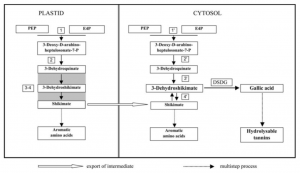All hydrolysable tannins need gallic acid as their original building block, but its origin remained long as a biosynthetic enigma
 According to the current consensus, gallic acid is formed from an intermediate compound of the upstream reactions of the shikimate pathway, most probably from 3-dehydroshikimic acid, and that the reaction is catalysed by a specific dehydrogenase. However, this enzyme was not detected in plants or micro-organisms until 2003, when Ossipov et al. found a highly active enzyme, dehydroshikimate dehydrogenase (DSDG), which catalysed the direct conversion of 3-dehydroshikimic acid into gallic acid. There have not been any studies linking the activity of this enzyme to the observed tannin levels, but it is possible that part of the high between-tree, between-species, and seasonal variation in the foliar content of HTs could be attributed to the activity of DSDG.
According to the current consensus, gallic acid is formed from an intermediate compound of the upstream reactions of the shikimate pathway, most probably from 3-dehydroshikimic acid, and that the reaction is catalysed by a specific dehydrogenase. However, this enzyme was not detected in plants or micro-organisms until 2003, when Ossipov et al. found a highly active enzyme, dehydroshikimate dehydrogenase (DSDG), which catalysed the direct conversion of 3-dehydroshikimic acid into gallic acid. There have not been any studies linking the activity of this enzyme to the observed tannin levels, but it is possible that part of the high between-tree, between-species, and seasonal variation in the foliar content of HTs could be attributed to the activity of DSDG.
